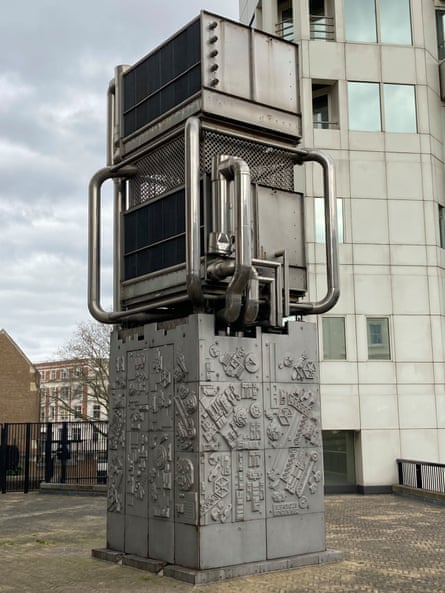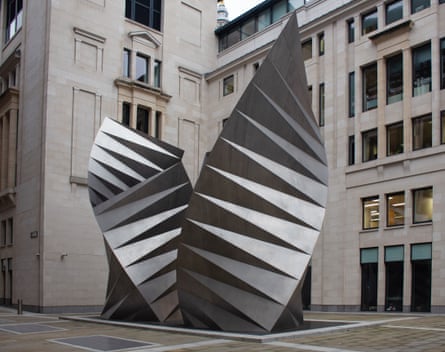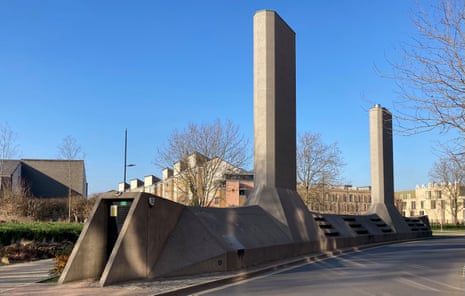A gas lamp still flickers on the corner of Carting Lane in the City of Westminster, adding a touch of Dickensian charm to this sloping alleyway around the back of the Savoy Hotel. The street used to be nicknamed Farting Lane, not in reference to flatulent diners tumbling out of the five-star establishment, but because of what was powering the streetlamp: noxious gases emanating from the sewer system down below.
The Sewer Gas Destructor Lamp, to give the ingenious device its proper patented name, was invented by Birmingham engineer Joseph Webb in 1895, and it still serves the same purpose today. As a plaque explains, it burns off residual biogas from Joseph Bazalgette’s great Victorian sewer, which runs beneath the Victoria Embankment at the bottom of the lane. It is the last surviving sewer-powered streetlamp in London, but it is one of many such curious vents, shafts and funnels scattered across the city, servicing the capital’s underground workings in all manner of unlikely disguises, now brought together in a fascinating gazetteer, titled Inventive Vents.
“We were led to the topic by Eduardo Paolozzi,” says Judy Ovens, cofounder of Our Hut, the architectural education charity behind the project. “We had always admired his robotic metal sculpture in Pimlico, but never realised it was actually designed as a ventilation shaft for an underground car park.”

Paolozzi’s striking metallic totem pole set the team, and their army of volunteers, off on a subterranean treasure hunt. Listening for unusual hums emanating from statue plinths, looking out for wisps of steam rising from kiosk rooftops, and consulting engineers’ maps, they have charted a plethora of hidden portals to the secret worlds that rumble away below the streets of the capital, compiled using the Layers of London website. From sewage pipes and road tunnels to tube lines and emergency government bunkers, the bowels of underground London have to expel fumes, suck in fresh air and allow people to maintain its mechanisms, all of which require access to and from its depths. The range of novel disguises in this 100-page book is remarkable, opening our eyes to an entire genre of structures hidden in plain sight, as varied and unexpected as the functions they serve.
Some try their best to blend into the background. Look closely at the stone plinths supporting statues in the City of London and you might spot grilles giving away their dual purpose. The bronze statue of James Henry Greathead, the engineer who pioneered the method of digging deep-level tunnels for the tube, appropriately stands atop an oval Portland stone plinth which also doubles up as a ventilation shaft for Bank station. Nearby, decorative grilles beneath the Duke of Wellington and his horse serve the same function. The draughty theme follows the duke across town: the Wellington Arch at Hyde Park Corner had its south side gutted in the 1960s to make room for vents for the road underpass below, given away by a small rectangular grille on one side.

The multiple layers of mouldings and twiddly details of classical architecture have proved useful for such deception, providing handy hiding places for grilles, vents and flues. When the Victoria Line was being constructed in the 1960s, residents of Gibson Square in Islington were horrified by the prospect of a concrete ventilation shaft erupting through their neat lawn. After a vocal campaign, classical architects Raymond Erith and Quinlan Terry were hired to provide a decorous disguise for the shaft, crafting a strange miniature temple topped with a cage-like dome, and a frieze appropriately derived from the Tower of the Winds in Athens.
The PoMo-classical trickery continued at Paternoster Square in the 1990s, where William Whitfield cleverly distracted people from the existence of a massive underground carpark by erecting a gigantic Corinthian column, crowned with a flaming golden urn. Awestruck by the gilded beacon, and the water features trickling down the base of the column, you might not notice the grilles running beneath the steps of its octagonal stone plinth, emanating exhaust fumes from below.

While the City has often opted to camouflage its flues, across the river architects have been allowed to let rip. Lambeth is particularly fertile ground for vent-spotters, with a range of bold brutalist shafts bursting from the streets. One local favourite is the Camberwell Submarine, an enigmatic chimney-topped bunker that looks like something left over from the cold war. It was designed by borough architects Michael Luffingham and Bill Jacoby in the 1970s, as ventilation for an underground boiler room for the nearby housing estates; but its concrete chimneys were recently extended by a whopping four metres, making it an even more surreal sight to stumble across (if now a little less like a submarine and more like an underground crematorium).
Meanwhile the Metropolitan Police Forensic Science Laboratory, at 109 Lambeth Road, may be unsigned, but it makes its presence known with a striking concrete vent for its own emergency substation, providing “full electrical resilience” in the case of a power cut. It is of a similar style to Victoria Line shaft up the road where, amid the car crash of ugly towers currently rising around Vauxhall station, this chiselled corduroy concrete wedge holds its own, jutting from the street corner with a powerful angular presence, like a piece of the Barbican gone astray. (The Barbican itself is no stranger to inventive vents, featuring a curious concrete spiral based on the Fibonacci sequence.)
There are countless other marvels dotted around town. One of Terry Farrell’s first projects in the 1960s, when he was working at the London County Council in his 20s, still brings a moment of delight to an unlovely corner of Poplar. Now wedged between a cluster of towers, a bulging pair of concrete funnels signal the presence of the Blackwall Tunnel beneath the river, channelling exotic strains of Oscar Niemeyer to the East End. Nearby, the momentous portal to the Limehouse Link tunnel makes driving under the river as exciting as descending into an Aztec temple. Back in the City, one of Thomas Heatherwick’s earliest and most successful projects brings a dose of twisting whimsy to a yard around the corner from Paternoster Square, in the form of a pair of origami-like Angel’s Wings to vent an electricity substation. Meanwhile, if you stand for long enough outside the octagonal kiosk at Oval station, you’ll see its rooftop netting rise and fall with the passing trains below, like the gentle breathing of some underground beast.

But the most secretive vents are the most humdrum of all. A pair of round, well-like stone structures outside the Queen Elizabeth II Centre in Westminster might look like something to do with the nearby public toilets, but they were in fact installed to vent an underground government “citadel”. It was built in the 1950s to house an emergency telephone exchange as part of a secret tunnel system that linked Whitehall with other strategic points around the city, allowing the state to function in the event of a nuclear attack. The details are protected in the National Archives, awaiting declassification in 2026 – a timely moment for an expanded second edition of this gazetteer to unlock further secrets of London’s mysterious underworld.

Comments (…)
Sign in or create your Guardian account to join the discussion